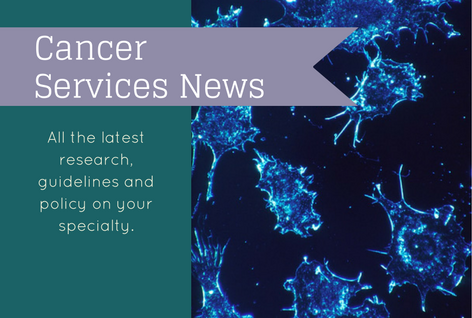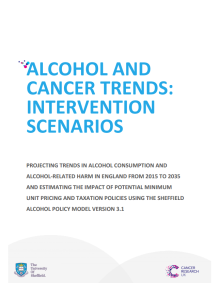
Welcome to the Cancer Services online newsfeed. Here you’ll find all the latest research, news stories, policy updates and guidelines. View our other newsfeeds for more subject-specific news.

Welcome to the Cancer Services online newsfeed. Here you’ll find all the latest research, news stories, policy updates and guidelines. View our other newsfeeds for more subject-specific news.
Hundreds of thousands of healthy women should take pills to cut their risk of breast cancer, says NHS watchdog NICE | BBC News

The draft guidelines for England say women predisposed to breast cancer because of a strong family history of the disease need this protection.
There are now three drugs to choose from – tamoxifen, raloxifene and, for the first time, anastrozole. Anastrozole is cheaper than the other two and, for some women, has fewer side-effects and is more effective.
Read the full news story here
Read the NICE draft guidelines here
Corbett, T. et al. BMC Cancer. Published online: 25 November 2016

Background: Cancer-related fatigue (CrF) is a common and disruptive symptom that may be experienced during and after cancer. Research into the subjective experience of fatigue in this group is required. The common sense model of self-regulation of health and illness (SRM) addresses personal beliefs or mental representations—whether medically sound or unsubstantiated— that a person holds about a health issue. The current study assesses if the SRM could be used as a theoretical framework for organizing the experiences of people with CrF, with a view to identifying methods to address fatigue in cancer survivors.
Conclusion: This study explored the subjective experience of fatigue after cancer using the SRM. CrF should be approached as a complex psychosocial issue and considered from the patient perspective to facilitate better understanding and management of symptoms. The SRM is an applicable framework for identifying modifiable factors that could lead to improved coping with CrF in post-treatment cancer survivors.
Read the full abstract and article here
A new Cancer Research UK analysis reveals that rates of mouth (oral) cancer have jumped by 68% in the UK over the last 20 years.

The figures – released during Mouth Cancer Action Month – reveal the cancer is on the rise for men and women, young and old, climbing from eight to 13 cases per 100,000 people over the last two decades.
For men under 50, the rate has jumped by 67 per cent in the last 20 years – going up from around 340 cases to around 640 cases each year. For men aged 50 and over, rates have increased by 59 per cent climbing from around 2,100 cases to around 4,400 cases annually. Oral cancer is more common in men, but there have been similar increases women.
Read the full press release here
Guillermo Lorenzo et. al. Tissue-scale, personalized modeling and simulation of prostate cancer growth. Proceedings of the National Academy of Sciences, 2016; 201615791 DOI: 10.1073/pnas.1615791113
New research coauthored by Brigham Young University researchers may lead to a more accurate system for early detection, diagnosis, and treatment of prostate cancer.
The new study, published in Proceedings of the National Academy of Sciences, details a computer model that uses medical images to reproduce the growth patterns of prostate cancer on the anatomy of a patient’s prostate.
This type of mathematical modelling and simulation of disease (aka predictive medicine) can lead to personalised treatment and more accurate forecasting of clinical outcomes.
Current diagnosis methods include invasive biopsy procedures which too often lead to patients being over-treated or under-treated. Complicating matters is the fact that prostate cancer can remain undiagnosed because early stages of the disease may not produce symptoms until a tumour is either very large or has invaded other tissues.
The new system could lead to both earlier diagnosis and less invasive testing.
Full document available here
Cancer Research UK has published Testing times to come? An evaluation of pathology capacity across the UK.

This report highlights lack of capacity for pathology services as a result of the increasing number of patient samples that need to be tested. The report recommends that action is taken now to address current and future workforce shortfalls. It also recommends the Royal College of Pathologists should update their guidance and look at ways to attract staff to train in pathology.
Download the executive summary for England
Additional links: Cancer Research UK press release | BBC News report
A new Australian study of men with advanced prostate cancer, published in the Journal of Clinical Oncology, suggests mindfulness training offers no benefit in this particular setting | The Conversation

In cancer, mindfulness-based therapies are often suggested as a supportive care option for patients. Mindfulness as the core component of these two approaches centres around teaching open awareness of the present experience and a focus on behaviour.
The behaviour element encourages the individual to conduct self observation of habits, and to become less reactive to difficult or unpleasant experiences. This is proposed to create a sense of calmness and composure – often referred to as equanimity – about the illness experience.
While mindfulness approaches intuitively seem well matched to the cancer context, to date the research in this area has been limited by variable study quality and a focus on breast cancer patients.
Read the full commentary here
Read the original research article here
Sathornviriyapong, A. et al. BMC Palliative Care. Published online: 21 November 2016

Background: Concerns that opioids may hasten death can be a cause of the physicians’ reluctance to prescribe opioids, leading to inadequate symptom palliation. Our aim was to find if there was an association between different opioid doses and the survival of the cancer patients that participated in our palliative care program.
Conclusions: Our study has demonstrated that different opioid doses in advanced cancer patients are not associated with shortened survival period.
Read the full abstract and article here
Mercadante, S. & Portenoy, R. K. (2016) Pain. 157(12) pp. 2657–2663

Breakthrough cancer pain (BTcP) is an episode of severe pain that “breaks through” a period of persistent pain at least partly controlled by a stable opioid regimen. Although mentioned in the literature decades ago, it has been only 25 years since the first effort to define and measure it.
Controversy about the definition of BTcP continues despite an international effort to achieve consensus. Nevertheless, common approaches to measurement of BTcP have led to a robust literature, including many surveys that have described prevalence, characteristics, and association with adverse outcomes. Measurement also has been important for clinical trials of new drug formulations specifically designed for BTcP. Several approaches have been reported in the literature, although most of them have never been substantiated with appropriate studies. Administration of an opioid as needed is the most common treatment.
Twenty-five years of research has produced a more refined understanding of the safety and efficacy of oral opioids in this context, and provided the clinical trials data necessary to attain regulatory approval of multiple new formulations specifically developed for BTcP. Transmucosal formulations of fentanyl may provide meaningful analgesia within 5 to 15 minutes. Given the difference in cost, transmucosal formulations should be considered in a subset of patients with BTcP, including those with pain that are not adequately controlled with an oral drug and those with distress associated with the rapid pain onset. The long-term use of opioids for BTcP remains to be clarified. Future studies should assess the potential of personalized treatment of BTcP.
Read the abstract here
Alcohol will cause around 135,000 cancer deaths over the next 20 years and will cost the NHS an estimated £2 billion in treatments, according to estimates from a new report by Sheffield University, commissioned by Cancer Research UK

The new figures, published today (Friday), reveal that by 2035 the UK could see around 7,100 cancer deaths every year that are associated with alcohol. Of the cancer types included in the report, oesophageal cancer is set to see the largest increase, followed by bowel cancer, mouth and throat cancer, breast cancer and liver cancer.
The report also forecasts that there will be over 1.2 million hospital admissions for cancer over the 20 year period, which will cost the NHS £100 million, on average, every year.
The results were based on analyses that assume alcohol drinking trends will follow those seen over the last 40 years, and takes recent falls in alcohol consumption, including among young people, into account.
Evidence suggests that the more alcohol you drink, the higher the risk of cancer. UK government guidelines, published earlier this year, advise that both men and women drink no more than 14 units of alcohol a week.
Read the full overview here
Read the full report here